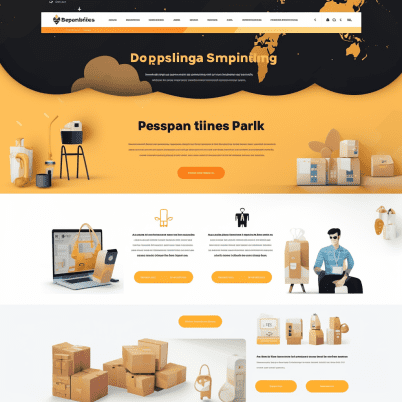Introduction
In the dynamic landscape of e-commerce, drop shipping in Australia has emerged as a revolutionary business model that enables entrepreneurs to sell products without the burden of inventory management. Australia, with its thriving online retail market, is an excellent platform for drop shipping ventures. In this comprehensive guide, we’ll delve into the intricacies of drop shipping in Australia, focusing on the crucial keyword “drop shipping Australia.” From understanding the concept of drop shipping to crafting a winning strategy, this article will equip you with the knowledge you need to establish a successful drop shipping business Down Under.

1. What is Drop Shipping in Australia?
Definition of Drop Shipping in Australia:
Drop Shipping in Australia is a retail fulfillment method where a store doesn’t keep the products it sells in stock. Instead, when a store sells a product, it purchases the item from a third party and has it shipped directly to the customer. This eliminates the need for inventory management and storage.
How Drop Shipping Works:
Drop Shipping in Australia involves three key players: the retailer (you), the supplier, and the customer. When a customer places an order on your online store, you relay the order and shipping details to the supplier. The supplier then ships the product directly to the customer. This model allows you to focus on marketing and customer service rather than handling inventory.
Advantages of Drop Shipping:
- Low Startup Costs: Drop Shipping in Australia eliminates the need to invest in inventory, reducing upfront costs.
- Wide Product Range: With no physical inventory, you can offer a diverse range of products to customers.
- Location Flexibility: Operate your business from anywhere with an internet connection.
- Reduced Risk: Since you only purchase products when you make a sale, there’s less financial risk involved.
2. E-commerce Landscape in Australia
Online Shopping Trends:
Australians have embraced online shopping, driven by convenience, variety, and competitive pricing. A significant percentage of consumers now prefer to shop online for both essentials and luxury items.
Growth of E-commerce Market:
The Australian e-commerce market has witnessed remarkable growth over the years, with the trend expected to continue. The ease of internet access and the widespread use of smartphones have contributed to this expansion.
Opportunities for Drop Shipping:
As the e-commerce market flourishes, Drop Shipping in Australia offers an excellent opportunity for entrepreneurs to tap into this growing demand. you can target customers seeking unique products and hassle-free shopping experiences.
3. Keyword Research:
Importance of Keywords:
Keywords are the foundation of search engine optimization (SEO). They help your content appear in search results when users search for relevant terms.
Analyzing:
Use tools like Google Keyword Planner to understand the search volume and competition for the keyword “drop shipping in Australia.” Identify related keywords and long-tail variations to diversify your content strategy.
Long-Tail Keywords and Their Significance:
Long-tail keywords are more specific phrases that cater to niche audiences. For instance, “best drop shipping suppliers in Australia” or “tips for successful drop shipping in Australia.” Targeting long-tail keywords can help you reach a more engaged and interested audience.
4. Setting Up Your Drop Shipping Business
Niche Selection:
Choose a niche that aligns with your interests and market demand. Conduct market research to identify profitable niches that have room for growth.
Supplier Partnerships:
Establish relationships with reliable suppliers who offer quality products and efficient shipping. Verify their credibility and ensure they support drop shipping in Australia arrangements.
Legal and Tax Considerations:
Register your business, obtain necessary licenses, and understand taxation regulations. Clearly communicate shipping times, return policies, and terms of service on your website.
5. Building a User-Friendly E-commerce Store
Choosing the Right E-commerce Platform:
opt for an e-commerce platform that aligns with your needs and budget. Consider platforms like Shopify or Woo Commerce for their user-friendly interfaces and customizable options.
Design and User Experience:
Create a visually appealing website that’s easy to navigate. A clean design, intuitive layout, and clear product categorization can enhance user experience.
Mobile Responsiveness:
Given the prevalence of mobile shopping, ensure your website is mobile-responsive. Google also prioritizes mobile-friendly sites in search rankings.
6. Content Marketing and SEO for Drop Shipping
Creating High-Quality Product Descriptions:
Craft detailed and compelling product descriptions that highlight features, benefits, and potential uses. Use high-quality images to enhance the visual appeal.
Integrating Keywords Naturally:
Incorporate the keyword and related terms naturally into your product descriptions and blog posts. Avoid keyword stuffing, which can harm your SEO.
Starting a Blog to Boost SEO:
Launching a blog on your website allows you to create informative and valuable content related to drop shipping in Australia and e-commerce. Write articles that address common concerns, share tips, and showcase success stories.
7. Optimizing for Local Searches
Importance of Local SEO:
Local SEO helps you appear in search results when users look for businesses in their vicinity. It’s crucial for targeting a drop shipping in Australian audience.
Google My Business for Local Presence:
Create and optimize your Google My Business listing. Include accurate business information, photos, and customer reviews to enhance local visibility.
Tailoring Content for Australian Audience:
Use drop shipping in Australian spellings, cultural references, and address local issues in your content to resonate with the target audience.
8. Effective Strategies to Drive Traffic
Social Media Marketing:
Leverage platforms like Instagram, Facebook, and Pinterest to showcase products, engage with your audience, and run targeted ad campaigns.
Influencer Collaborations:
Partner with drop shipping in Australian influencers who align with your niche. Their endorsements can help you reach a wider audience and build trust.
Pay-Per-Click (PPC) Advertising:
Consider Google Ads to bid on relevant keywords and appear in the top search results. This can drive immediate traffic to your site.
9. Conversion Rate Optimization (CRO)
Streamlined Checkout Process:
Simplify the checkout process to reduce cart abandonment. Offer multiple payment options and ensure a secure and smooth payment experience.
Customer Reviews and Trust Signals:
Display customer reviews, ratings, and trust badges prominently. Positive social proof can influence purchasing decisions.
A/B Testing for Continuous Improvement:
Experiment with different layouts, colors, and wording to see what resonates best with your audience. A/B testing helps refine your website and boost conversions.
10. Managing Inventory and Order Fulfillment
Inventory Management Tools:
Invest in inventory management software that helps you keep track of stock levels, reorder products, and avoid overselling.
Overcoming Shipping Challenges:
Keep customers informed about shipping times and potential delays. Partner with suppliers who offer reliable and efficient shipping methods.
Customer Communication:
Establish clear lines of communication with customers. Provide tracking information and respond promptly to inquiries to build trust.
11. Customer Service and Retention
Providing Exceptional Customer Support:
Offer prompt and helpful customer service through various channels, including email, chat, and phone. A positive experience can lead to repeat business and referrals.
Implementing a Loyalty Program:
Reward returning customers with discounts, exclusive offers, or loyalty points. This encourages repeat purchases and fosters customer loyalty.
Encouraging Repeat Business:
Send personalized follow-up emails, recommend related products, and offer special deals to entice customers to return to your store.
12. Monitoring, Analytics, and Growth
Tracking Key Metrics:
Monitor important metrics for drop shipping in Australia like website traffic, conversion rates, bounce rates, and sales. This data guides your decision-making and highlights areas for improvement.
Google Analytics for Insights:
Utilize Google Analytics to gain insights into user behavior, traffic sources, and the effectiveness of your marketing efforts.
Scaling Your Drop Shipping Business in Australia:
As your business grows, consider expanding your product range, exploring new marketing channels, and refining your strategies to reach a wider audience.
13. Challenges and How to Overcome Them
Intense Competition:
The drop shipping landscape can be competitive. Differentiate yourself through exceptional customer service, unique products, and effective marketing strategies.
Shipping Delays and Customer Expectations:
Communicate transparently about shipping times and potential delays. Set realistic expectations to avoid disappointing customers.
Adapting to Market Changes:
Stay updated on market trends, customer preferences, and changes in search engine algorithms. Adapt your strategies to remain relevant.
Conclusion
Embarking on a journey for drop shipping in Australia offers boundless potential for success. By meticulously understanding the concepts outlined in this guide and harnessing the power of the “drop shipping in Australia” keyword, you can lay the groundwork for a thriving online business. Remember, persistence, adaptability, and a commitment to customer satisfaction will propel your drop shipping venture to new heights in the dynamic e-commerce landscape of Australia.
FAQ
1: What Exactly is Drop Shipping?
drop shipping in Australia is a retail fulfillment method where a store sells products without holding any inventory. When a product is sold, it’s purchased from a third-party supplier, who then ships it directly to the customer.
2: Is Drop Shipping Profitable in Australia?
Yes, drop shipping can be profitable in Australia due to the growing e-commerce market and consumers’ increasing preference for online shopping.
3: Do I Need to Hold Inventory with Drop Shipping?
No, one of the main benefits of drop shipping is that you don’t need to hold inventory. Products are only purchased from suppliers when a customer places an order.
4: How Can I Find Reliable Suppliers for Drop Shipping in Australia?
You can find reliable suppliers by conducting thorough research, reading reviews, and reaching out to potential partners. Consider using platforms like Oberlo or SaleHoo to connect with verified suppliers.
5: Do I Need a Business License to Start a Drop Shipping Business in Australia?
Yes, it’s recommended to register your business and obtain any necessary licenses based on the local regulations and laws in Australia.
6: Can I Choose Any Niche for My Drop Shipping Business?
While you have flexibility in choosing a niche, it’s advisable to select a niche that aligns with market demand and your interests. Conduct thorough research to identify viable niches.
7: How Can I Optimize My E-commerce Store for Local Searches in Australia?
To optimize for local searches, create a Google My Business listing, use local keywords, include Australian cultural references, and provide accurate business information.
8: What Strategies Can I Use to Drive Traffic to My Drop Shipping Store?
You can drive traffic through social media marketing, influencer collaborations, pay-per-click advertising, content marketing, and search engine optimization (SEO).
9: How Can I Ensure Timely Shipping and Customer Satisfaction?
Work closely with your suppliers to ensure timely shipping and communicate shipping times transparently to customers. Provide exceptional customer service to address any concerns promptly.
10: What’s the Biggest Challenge in Drop Shipping and How Can I Overcome It?
Answer: One of the challenges is intense competition. To overcome it, focus on differentiating your store through unique products, outstanding customer service, and effective marketing strategies. If you’re seeking to expand your knowledge or consult with a premier e-commerce expert, don’t hesitate to get in touch.




